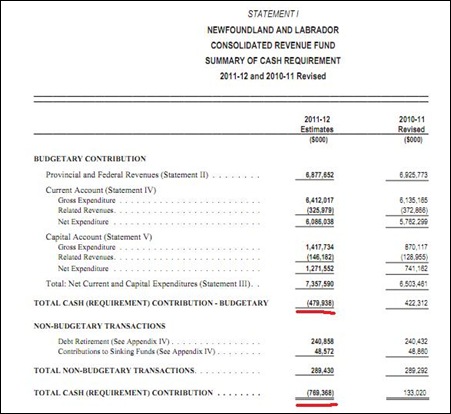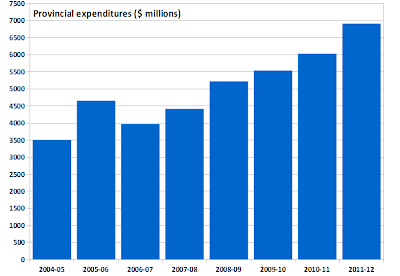[continued from Part 2]
Debt
One of the issues Wade Locke set out to address was the impact Muskrat Falls would have on public debt. For some other information on Muskrat Falls and public debt, check this earlier post.
Slide 43 is a table of debt servicing amounts based on the amount borrowed and the rate of interest amortized over a 30 year time. For example, $3.0 billion at 5% would cost $195 million in annual payments to pay the principle and interest. on the opposite end of Locke’s scale, $8.0 billion at 10% would cost $849 million each year.
Earlier in his presentation, Locke asserted that the provincial government can currently borrow money at 5% while Nalcor can borrow money at 7.5%.
The money to meet those payments would come from only one source: electricity rates. As noted right at the beginning of the presentation, the entire project is proposed based on having the ratepayers of Newfoundland and Labrador carry 100% of the cost.
This money would be in addition to other Nalcor costs for producing electricity in the province. The public utilities board is responsible for setting electricity rates in the province. The board must allow Nalcor to recover its costs plus provide a rate of return – essentially a profit – on its operations. The board will also add an amount for Newfoundland Power, the electricity distributor on the island to determine the rate paid by residential and industrial consumers.
One of the important pieces of information needed to determine the impact on the public debt and rates would be the amount of money, if any, that Nalcor would raise or how it would raise the money. Equity investors, borrowing or subsidy from the provincial government all carry different implications for public debt.
There are different possibilities. Locke did not discuss them. Instead he relied on other information as he presented on Slide 44. Locke did not indicate in the slides or his presentation where he got the information.
According to Locke (Slide 44), Nalcor would generate $550 million from its proposed rate (7.5 cents per kilowatt hour). This would allow Nalcor to cover a loan of $8 billion at 5% with $100 million left for “other expenditures”., according to Locke.
He also claims that revenue from “residual power” would generate up to $60 million. This “residual power” is the power other than that designated for use in Newfoundland and Labrador or the portion shipped free to Nova Scotia.
As a result, Locke concludes, the extra debt won’t be a problem for the provincial government or Nalcor. Locke has not explained how he reaches this conclusion other than by the circular logic that since Nalcor has provided enough theoretical money in its estimates to cover the payments, the payments will be covered and therefore there is no problem.
Since Locke does not explore other possible financing options, he has no basis to offer any assessment of how those financing options might affect public debt and public spending.
For example, the provincial government might opt to give borrow money at its lower rate of interest and give it to Nalcor as a gift. That may not be the current plan but it is one way of handling unanticipated massive cost over-runs. That would affect the amount Nalcor could charge in rates and it also changes the amount taxpayers would have to divert from other expenditures to service the larger, direct public.
There are other curious points in Locke’s slides. He does not explain why the residual power would net slightly more than 10% of the revenue generated within Newfoundland and Labrador for the same amount of electricity.
Most significantly, though, Locke does not explain where this power would be sold. There are no current sales for it, nor are there any likely sales given the state of markets in nearby states or provinces. in other words, Locke is just speculating and his amounts for “residual power” are fictitious.
Financing such a large project has significant implications for public finance in the province. Locke disposes of the issue in two slides. They appear to be based on a series of unsubstantiated assumptions or claims such as Locke’s assertion that Nalcor’s proposed rates would definitely give money “left over to retire other provincial debt, to fund other public services or to reduce taxes.”
At best, those are policy decisions not taken, yet Locke pushes them out there as if they were real benefits. The assumed benefits are based on other apparently untested assumptions, including the one that Nalcor’s calculations are right.
Assuming the can opener
Locke’s last series of slides (45 and 46) cap off a series of unsubstantiated claims with a flourish of more.
For example, on Slide 45, Locke claims that a connection to the ‘North American grid” would allow other energy developments including onshore wind potential on the island and Labrador or “stranded” natural gas.
The province is already connected to the North American grid from Labrador. We do not need Muskrat Falls to facilitate the development of wind energy in Labrador.
An interconnection to Nova Scotia would allow Nalcor and others to develop wind potential on the island. We don’t need Muskrat falls to do that.
As for exports, Locke failed to examine any potential export markets. There are none, especially for very expensive power at Muskrat Falls that grows even more expensive when transported the long distances from Labrador or the island to market.
Locke does not seem to recognise the logical problem in his claim about gas. If gas is too expensive to produce electricity to beat Muskrat Falls electricity, then it is highly unlikely that natural gas could make electricity in Newfoundland and Labrador that could be cost competitive in markets where even Muskrat Falls is too expensive to penetrate successfully.
Recall that, as Jim Feehan noted, US producers are making electricity from natural gas next to the market that costs no more than four cents per kilowatt hour to produce and very little to transport. If Muskrat Falls electricity will cost at least 14.3 cents per kilowatt hour in St. John’s, imagine what it would cost to shop the same electricity to Ontario? No wonder Nalcor can’t sell the power outside the province and could only give it away free to Nova Scotia.
Locke’s Conclusion
Locke’s conclusion essentially repeats the untested assumptions/assertions of his presentation.
He does add a new one:
Without the extra energy made available by Muskrat Falls, there is serious questions whether or not the mining projects expected in Labrador within the next 10 years can proceed. Currently, we do not have sufficient recall power. If all these projects proceed as expected, we may need another 400 to 500 MW of power. This may require the development of additional resources on the island (hydro, wind, etc.)
His claim that “we do not have sufficient recall power” is simply not true. In the same way that Locke ignored surplus electricity on the island , he also ignores the 5800 megawatts of electricity available in Labrador for future development.
Churchill Falls electricity is available under the right circumstances, including a use of the Electrical Power Control Act’s provisions on electricity control and availability within the province.
The rest is just grasping. Labrador also offers other hydro-electric and wind resources that could meet an industrial need. What’s more, Muskrat Falls could supply a Labrador contingency on its own without an interconnection to the island. After all, if the island and Nova Scotia would need 60% of Muskrat Falls electricity, the remainder would be insufficient to meet an industrial development of the size Locke suggests. It would be far cheaper and easier to meet Labrador needs with Labrador power rather than develop “additional resources on the island” that Locke and Nalcor have already insisted either don’t exist or are too expensive to develop.
- srbp -






